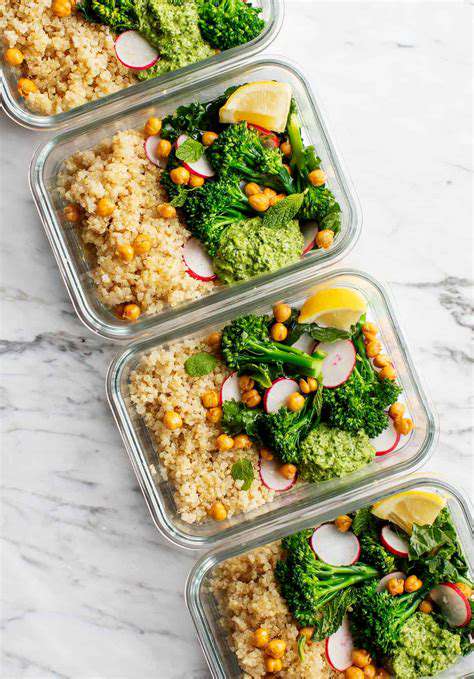Breakfast Ideas
Quick and Easy Breakfasts
For those mornings when you're short on time but still want a nutritious and satisfying breakfast, there are plenty of quick and easy options. Overnight oats are a fantastic choice, combining rolled oats, milk (dairy or non-dairy), and your favorite toppings like fruit, nuts, and seeds. Simply combine the ingredients in a jar or container the night before, refrigerate, and grab and go in the morning. This allows you to prepare your breakfast ahead of time, ensuring a healthy and convenient start to your day.
Another quick option is a smoothie. Blend fruits like berries, bananas, or mangoes with yogurt, milk, and spinach for a nutrient-packed and delicious breakfast. Experiment with different fruits and vegetables to find your favorite smoothie combinations. These can be customized to meet your dietary needs and preferences, making them a versatile and flexible option for breakfast.
Savory Breakfast Options
If you're looking for something savory to kickstart your morning, consider eggs. Scrambled, fried, or poached, eggs are a versatile protein source that can be easily paired with various vegetables and whole-grain toast. A simple scramble with diced tomatoes, onions, and peppers is a flavorful and filling breakfast option. Adding a side of whole-wheat toast or a small portion of whole-grain tortillas enhances the nutritional value of this meal.
Breakfast burritos are another fantastic savory option. Fill whole-wheat tortillas with scrambled eggs, black beans, salsa, and cheese. This provides a good balance of protein, fiber, and healthy fats. The combination of these ingredients creates a satisfying and nutritious breakfast, perfect for fueling your body for the day ahead.
Breakfast quesadillas are a delicious and easy way to enjoy a savory meal in the morning. Fill tortillas with scrambled eggs, cheese, and your favorite vegetables like peppers or onions. Cooking them on a griddle or in a pan creates a warm and satisfying breakfast, and they can be customized with different fillings to suit your taste and dietary preferences.
Breakfast tacos are another great way to incorporate flavorful and filling ingredients into your morning meal. Use whole-wheat tortillas and fill them with scrambled eggs, black beans, and salsa. Adding a dollop of Greek yogurt or a side of avocado can elevate the nutritional value of this breakfast option, ensuring you start your day with a well-balanced and flavorful meal.

Tips for Transitioning to a Flexitarian Diet
Understanding the Flexitarian Approach
A flexitarian diet is a dietary pattern that emphasizes plant-based foods while allowing for occasional consumption of animal products. It's a flexible approach that sits somewhere between a vegetarian and a completely omnivorous diet. This flexibility is key to its appeal, as it allows individuals to gradually reduce their meat intake without feeling deprived or overly restricted. This gradual transition is crucial for long-term adherence and can lead to sustainable lifestyle changes.
The core principle is to prioritize plant-based foods like fruits, vegetables, legumes, and whole grains, while incorporating lean proteins and healthy fats from animal sources in moderation. This approach recognizes that everyone's dietary needs are different, and the flexitarian diet empowers individuals to tailor their approach to their own circumstances and preferences.
Benefits of a Flexitarian Diet
Adopting a flexitarian diet can offer a wealth of health benefits. Increased consumption of fruits and vegetables provides a rich source of vitamins, minerals, and antioxidants, contributing to improved overall health and well-being. Reducing red meat intake can lower the risk of certain diseases, and the focus on whole foods often leads to improved digestion and a healthier gut microbiome. Furthermore, the emphasis on plant-based proteins can contribute to lower cholesterol levels and a reduced risk of heart disease.
Beyond the physical benefits, a flexitarian diet can promote a more mindful approach to eating. It encourages paying attention to food choices and the impact they have on your body and the environment. This increased awareness can lead to a more balanced and sustainable relationship with food, fostering long-term health and well-being.
Planning Your Flexitarian Meals
Creating delicious and satisfying flexitarian meals requires a little planning. One key strategy is to incorporate a variety of colorful vegetables into each meal. Think stir-fries, salads, soups, and roasted vegetables. Combining these with whole grains, legumes, and lean protein sources provides a balanced and nutritious meal. Exploring new recipes and experimenting with different cuisines can enhance the enjoyment of the dietary transition.
When incorporating animal products, choose lean cuts of meat, poultry, or fish. Consider using smaller portions and focusing on plant-based sides to maintain a balanced meal. This thoughtful approach ensures that the diet remains both healthy and enjoyable.
Gradual Transition Strategies
Transitioning to a flexitarian diet doesn't have to be a drastic change. Start by gradually reducing your meat consumption. Perhaps one day a week, or one meal a day. This approach allows your body and palate to adjust without feeling overwhelmed. Focus on introducing more plant-based meals into your routine, gradually increasing their frequency.
Addressing Potential Challenges
One common challenge in adopting a flexitarian diet is finding delicious and satisfying alternatives to traditional meat-based meals. Explore creative recipes and cooking methods to overcome this hurdle. Experiment with different spices, herbs, and flavor combinations to enhance the taste of plant-based dishes. Staying well-informed about nutritional needs and seeking guidance from registered dietitians or nutritionists can be invaluable in addressing specific concerns.
Making it a Sustainable Lifestyle
The key to a successful flexitarian diet is making it a sustainable lifestyle choice. Focus on incorporating healthy habits that promote overall well-being. Prioritizing mindful eating, regular exercise, and sufficient sleep will support both physical and mental health. Creating a supportive environment and surrounding yourself with like-minded individuals can also be helpful in maintaining motivation and consistency.
Remember, the goal is to find a dietary approach that works for you. Be patient with yourself, celebrate small victories, and remember that the journey is as important as the destination.